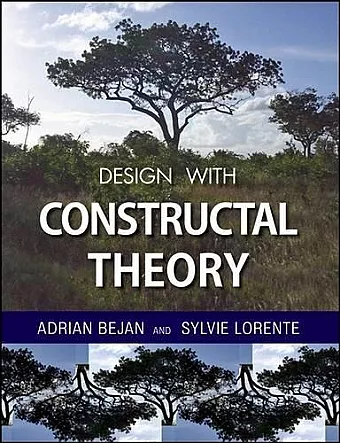Design with Constructal Theory
Sylvie Lorente author Adrian Bejan author
Format:Hardback
Publisher:John Wiley & Sons Inc
Published:26th Sep '08
Currently unavailable, and unfortunately no date known when it will be back

Design course on the universal principle of configurations in nature and engineering-the constructal law
Design with Constructal Theory offers a revolutionary new approach based on physics for understanding and predicting the designs that arise in nature and engineering, from the tree and the forest to the cooling of electronics, urban design, decontamination, and vascular smart materials. This book shows how you can use the method of constructal theory to design human-made systems in order to reduce trial and error and increase the system performance.
First developed in the late 1990s, constructal theory holds that flow architecture arises from the natural evolutionary tendency to generate greater flow access in time and in flow configurations that are free to morph. It unites flow systems with solid mechanical structures, which are viewed as systems for the flow of stresses. Constructal theory unites nature with engineering, and helps us generate novel designs across the board, from high-density packages to vascular materials with new functionalities (self-healing, self-cooling), and from tree-shaped heat exchangers to svelte fluid-flow and solid structures.
Design with Constructal Theory starts with basic principles and then shows how these principles are applied to understanding and designing increasingly complex systems. Problems and exercises at the end of each chapter give you an opportunity to use constructal theory to solve actual design problems.
This book is based on a design course developed by the two authors for upper-level undergraduates and graduate students at Duke University and other universities all over the world. With the authors' expert guidance, students and professionals in mechanical, civil, environmental, chemical, aerospace, and biomedical engineering will understand natural systems, and then practice design as science, by relying on constructal strategies to pursue and discover novel and effective designs.
"This book represents the outcome of over 12 years of research and teaching by the authors on constructal theory and its application. It provides comprehensive and elegant discussion of a revolutionary new approach for understanding and predicting the designs that arise in both nature and engineering, from the tree and the forest to the cooling of electronics, urban design, decontamination, and vascular smart materials. This book is highly recommended for everyone, especially students and professionals in mechanical, civil, environmental, energy and power, chemical, aerospace, and biomedical engineering, as well in geophysics and biology." (International Journal of Energy Research, 2010)
"The constructal law provides a broad coverage of "designedness" everywhere, from engineering to geophysics and biology….it provides the student with strategy for how to pursue and discover design-the configurations or patterns-in both space and time. Constructal theory pushes design thinking closer to science and away from art. It tears down the walls between engineering and natural sciences." (Mechanical Engineering, September 2009)
"A balance between individual and institutional approaches is the best idea, according to a new theory by a Duke University engineer Adrian Bejan, who thinks institutions benefit most from the co-existence of large groups that self-organize naturally and lone scientists coming up with brilliant new ideas…. big thinkers didn't disappear. Bejan argues they continued to thrive. He thinks his "constructal theory," which he began describing in 1996, might explain why. The theory states that so-called flow systems evolve to balance and minimize imperfections, reducing friction or other forms of resistance, so that the least amount of useful energy is lost. Examples in nature include rivers and streams that make up a delta or the intricate airways of the lungs. In research done by humans, Bejan sees two main flows: those of ideas in the form of scientific findings, and those of support, measured by tangible factors such as funding and lab space." (Robert Roy Brit, LiveScience.com, Yahoo.news.com, December 2008)
"Design with Constructal Theory offers a revolutionary new approach to design based on physics for understanding and predicting the designs that arise in nature and engineering…This book shows how you can use the method of constructal theory to design human-made systems in order to reduce trial and error and increase the system performance. It is beautifully illustrated, in color and black & white. This book is highly recommended to professors, students and professionals in mechanical, civil, environmental, chemical, aerospace and biomedical engineering. It is recommended to all the readers interested in design in nature, and in design as science, strategy, and novel and effective designs." (International Journal of Heat and Mass Transfer, 11/12/08)
ISBN: 9780471998167
Dimensions: 243mm x 198mm x 34mm
Weight: 1129g
560 pages